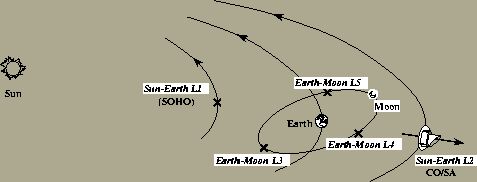Orbit/Navigation
A compromise between achieving large sky coverage, maintaining thermal stability, and rejecting solar straylight, results in a scan angle of 70o. The geometry of the spacecraft (constrained by the launcher fairing) is such that the payload will remain in the shadow of the Sun for spin-axis to Sun-vector angles of up to 15o. Thus, ecliptic latitudes as large as 85 degrees will be available for observation, or more than 99% of the whole sky.

Figure: Far-Earth orbit options for Planck. The L4 and L5 Lagrangian points of the Earth-Moon system are located at ~400 000 km from the Earth, while the L2 point of the Earth-Sun system is at a distance of ~1.5 x 106 km. The baseline is a Lissajous orbit around the L2 Lagrangian point of the Earth-Sun system.
The basic anti-Sun pointing strategy reduces the effects of solar radiation to a minimum; however, the Earth and Moon can also be intense sources of both straylight and thermal modulation, and reducing their effects drives the choice of orbit. Near Earth orbits are eliminated mainly because the large thermal influx renders it extremely difficult to reach temperatures near 100 K in the focal plane, or to achieve the required thermal stability. The nearest far-Earth orbit possible is that around one of the Lagrangian points of the Earth-Moon system; this orbit (which shares the Lunar motion around the Earth) suffers from the fact that the Earth or the Moon are often not very far from the telescope line-of-sight. Simulations indicate that if this orbit were chosen, at least 35% of the acquired data would have to be discarded due to poor thermal or straylight conditions, leading not only to lower sky coverage but also to a less efficient removal of systematic effects.
The optimal choice of orbit, resulting from a tradeoff of the various payload requirements, several spacecraft technical constraints (most importantly related to telecommunications to ground), and the transfer-to-orbit cost, is a Lissajous orbit around the L2 Lagrangian point of the Earth-Sun system. At this location the Sun, the Earth, and the Moon are all located behind the payload, where their undesirable effects are at the lowest possible level, both in terms of location and of flux. In addition, this is the only orbit in which the antennas which provide telemetry and telecommand (TM/TC) for the spacecraft are also continually pointed away from the payload, thereby minimizing the potential effects of RF interference.
